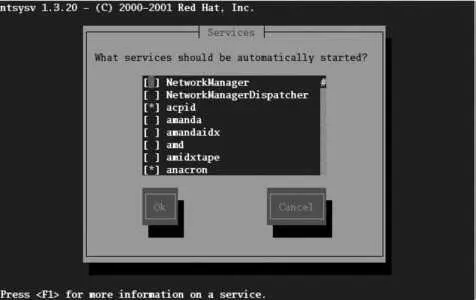To start, stop, or restart a service immediately, regardless of whether it's configured to start automatically at boot time, click on the service name and then click on the Start, Stop, or Restart icon.
4.6.1.1. Configuring services using a character user interface
If you're not running a graphical user interface, you can use ntsysv , a character-mode program similar to system-config-services :
# ntsysv
This will configure the current runlevel. To configure a different runlevel, use the --level option:
# ntsysv --level 4
The display shown in Figure 4-7 will appear.
Figure 4-7. The ntsysv display

Use the arrow keys to select a service, the spacebar to check/uncheck a service, and Tab to switch between the service list and the buttons. When you are done, press Tab to advance to the OK button and then press Enter.
4.6.1.2. Configuring services from the command line
The chkconfig command provides an easy way to enable and disable services. The --list option displays the current service configuration:
$ chkconfig --list
NetworkManager 0:off 1:off 2:off 3:off 4:off 5:off 6:off
NetworkManagerDispatcher 0:off 1:off 2:off 3:off 4:off 5:off 6:off
acpid 0:off 1:off 2:off 3:on 4:on 5:on 6:off
amd 0:off 1:off 2:off 3:off 4:off 5:off 6:off
anacron 0:off 1:off 2:on 3:on 4:on 5:on 6:off
apmd 0:off 1:off 2:on 3:on 4:on 5:on 6:off
arptables_jf 0:off 1:off 2:on 3:on 4:on 5:on 6:off
...(Lines snipped)...
If you specify a service name, then only the configuration for that service is shown:
$ chkconfig --list httpd
httpd 0:off 1:off 2:off 3:off 4:off 5:off 6:off
Note that each of the seven runlevels is shown, even though the configurations for runlevels 0 and 6 are ignored except for K files (since 0 is halt and 6 is reboot).
To enable a service in a runlevel, use the --level option to specify the runlevel along with the on argument:
# chkconfig --level 4 httpd on
# chkconfig --list httpd
httpd 0:off 1:off 2:off 3:off 4:on 5:off 6:off
To disable it, use the off argument:
# chkconfig --level 4 httpd off
# chkconfig --list httpd
httpd 0:off 1:off 2:off 3:off 4:off 5:off 6:off
To reset a service to its default configuration, use the reset argument. The configuration will be reset for the runlevel you specify, or for all runlevels if you don't include a - -level option:
# chkconfig --level 4 httpd reset
# chkconfig httpd reset
4.6.1.3. Managing services from the command line
The service command is used to manage running services. Two arguments are always used: first, the name of the service being managed, and second, the action that is to be performed. The most common actions are:
start
Start the service. This will fail if the service is already running.
stop
Stop the service. This will fail if the service is not running.
restart
Restart the service by stopping it and then starting it.
reload
Reload the configuration files for the service after they have been edited.
status
Display the current status of the service. This will indicate if the service is stopped or running; depending on the service, additional information may be displayed.
For example, to start the web service (named httpd ):
# service httpd start
Starting httpd: [ OK ]
You can then check its status:
# service httpd status
httpd (pid 13154 13153 13152 13151 13150 13149 13148 13147 13117) is running...
The pid values printed are the process IDs of the web server processes.
To make the web server reload its configuration file after it's been edited:
# service httpd reload
Reloading httpd: [ OK ]
Finally, to stop the web server:
# service httpd stop
Stopping httpd: [ OK ]
Services are managed by scripts in the /etc/rc.d/init.d directory; the name of each script corresponds to the name of the service. Each runlevel has its own directory named /etc/rc.d/rc .d , where is the runlevel.
If you examine a runlevel directory, you'll see names beginning with K or S , followed by a 2-digit number, followed by a service name:
$ ls /etc/rc.d/rc5.d
K01rgmanager K36postgresql K90isicom
K01yum K45arpwatch K92ipvsadm
K02NetworkManager K46radvd K94diskdump
K02NetworkManagerDispatcher K50netdump S01sysstat
K05innd K50snmpd S04readahead_early
K05saslauthd K50snmptrapd S05kudzu
K09dictd K50tux S06cpuspeed
...(Lines snipped)...
K35vncserver K85mdmpd S97messagebus
K35winbind K85zebra S98cups-config-daemon
K36dhcp6s K87multipathd S98haldaemon
K36lisa K89netplugd S99local
K36mysqld K89rdisc
All of these files are actually symbolic links to service scripts in /etc/rc.d/init.d , as shown by a long listing:
$ cd /etc/rc.d/rc5.d
$ ls -l S90xfs
lrwxrwxrwx 1 root root 13 Oct 5 14:37 S90xfs -> ../init.d/xfs
The scripts that start with S are used to start services, and the scripts that start with K are used to kill (stop) services. K scripts are only used when switching between runlevels after the system has been booted.
The digits in the filename are used to control the sequence in which the scripts are executed. This is essential because some services rely on others; for example, the web server relies on the network being up and running, so the network script must be run first.
When you examine the top of a service script, you will find a comment line containing the keyword chkconfig: followed by three arguments:
$ head /etc/rc.d/rc5.d/S90xfs
#!/bin/bash
#
# Id:$
#
# xfs: Starts the X Font Server
#
# Version: @(#) /etc/init.d/xfs 2.0
#
# chkconfig: 2345 90 10
# description: Starts and stops the X Font Server at boot time and shutdown. \
Читать дальше













